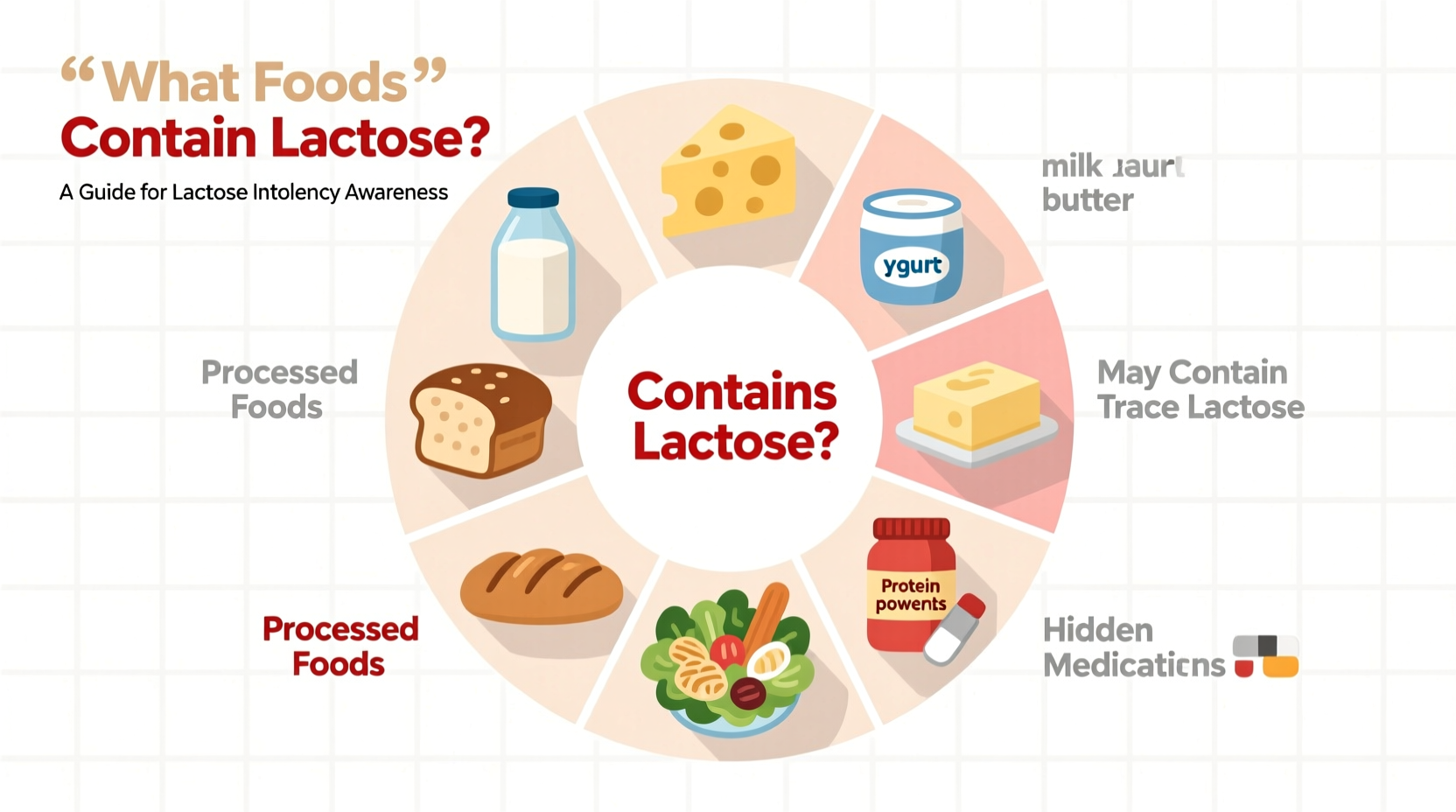Discover exactly which foods contain lactose and how to identify hidden sources in your diet. This comprehensive guide provides practical information for managing lactose intolerance, complete with verified lactose content levels, label-reading strategies, and real-world food examples you need to know.
Understanding Lactose in Your Food
Lactose, a natural sugar found in milk and dairy products, affects approximately 68% of the global population to varying degrees. For those with lactose intolerance, identifying lactose-containing foods isn't just helpful—it's essential for daily comfort and health management. Unlike a milk allergy, which involves the immune system, lactose intolerance stems from insufficient lactase enzyme production needed to digest this sugar.
According to the National Institute of Diabetes and Digestive and Kidney Diseases, lactose content varies significantly across dairy products based on processing methods and fermentation. This variation explains why some people can tolerate certain dairy foods while reacting to others.

High-Lactose Foods to Monitor Closely
Fresh dairy products typically contain the highest lactose levels. These foods require careful consideration if you're managing lactose intolerance:
- Milk (cow's, goat's, and sheep's) - all varieties including whole, skim, and flavored
- Fresh cheeses like ricotta, cottage cheese, and cream cheese
- Ice cream and frozen yogurt
- Yogurt without live active cultures
- Buttermilk
- Evaporated and condensed milk
Many people don't realize that dairy derivatives like whey, curds, and milk by-products also contain significant lactose. The FDA requires clear labeling of major allergens including milk, but lactose-specific labeling isn't mandatory, making ingredient scrutiny essential.
Hidden Sources of Lactose in Processed Foods
Lactose often appears in unexpected places beyond obvious dairy products. Food manufacturers use milk derivatives for texture, flavor, and browning properties. Common processed foods containing hidden lactose include:
- Bread and baked goods (whey is commonly added)
- Processed breakfast cereals
- Instant soups and sauce mixes
- Salad dressings and mayonnaise
- Processed meats like sausages and deli meats
- Non-dairy creamers (despite the name)
- Protein powders and meal replacement shakes
- Some medications and nutritional supplements
When reading food labels, watch for these lactose-containing ingredients: milk, lactose, whey, curds, milk by-products, dry milk solids, and nonfat dry milk powder. The presence of these ingredients doesn't always mean high lactose content, as processing can reduce levels significantly.
Lactose Content Comparison Across Common Foods
| Food Item | Typical Serving Size | Lactose Content (grams) | Tolerance Level |
|---|---|---|---|
| Cow's milk | 1 cup (240ml) | 11-13g | High |
| Ice cream | 1/2 cup (65g) | 3-6g | Medium-High |
| Cottage cheese | 1/2 cup (113g) | 2.7-4g | Medium |
| Cheddar cheese | 1 oz (28g) | 0.0-0.1g | Low |
| Greek yogurt | 1 cup (227g) | 2-4g | Low-Medium |
| Bread | 1 slice (28g) | 1-2g | Low-Medium |
This comparison, based on data from the USDA FoodData Central database, shows why some dairy products are more tolerable than others. Fermented dairy products like hard cheeses and Greek yogurt typically contain less lactose because the bacteria used in fermentation consume much of the sugar.
Reading Labels for Lactose Content
Effective label reading is your most powerful tool for identifying lactose sources. The FDA requires milk to be declared as an allergen, but doesn't specify lactose content. Here's what to look for:
- Allergen statements: "Contains: Milk" indicates the product contains dairy
- Ingredient list: Milk, lactose, whey, casein, curds, milk by-products
- Certifications: Look for "lactose-free" labels which indicate less than 0.1g per serving
- Processing notes: "Made in a facility that processes milk" indicates potential cross-contamination
Be aware that "dairy-free" doesn't always mean lactose-free—some products use dairy derivatives that still contain lactose. Similarly, "non-dairy" products like coffee creamers often contain sodium caseinate, a milk derivative with lactose.
Practical Strategies for Managing Lactose Intake
Successfully managing lactose intolerance involves more than just avoiding obvious dairy products. Implement these evidence-based strategies:
- Start with small portions: Many people can tolerate 4-8 ounces of milk when consumed with meals
- Choose fermented options: Yogurt with live cultures and aged cheeses typically have lower lactose
- Use lactase enzyme supplements: Taken before consuming dairy, these can improve tolerance
- Read beyond the dairy aisle: Check labels on bread, cereal, and processed foods
- Build calcium awareness: Ensure adequate calcium intake from non-dairy sources when eliminating dairy
Remember that lactose tolerance varies significantly between individuals. The American College of Gastroenterology notes that most people with lactose intolerance can consume at least 12 grams of lactose (about 1 cup of milk) in a single sitting without symptoms, especially when consumed with other foods.
Finding Lactose-Free Alternatives
Modern food options make managing lactose intolerance more manageable than ever. Consider these alternatives:
- Milk substitutes: Almond, soy, oat, and coconut milk (check for calcium fortification)
- Cheese alternatives: Aged cheeses naturally lower in lactose, or plant-based cheese options
- Yogurt options: Lactose-free dairy yogurt or plant-based yogurts with live cultures
- Butter substitutes: Ghee (clarified butter) contains minimal lactose
When selecting alternatives, check nutrition labels as some plant-based products contain added sugars or lack the protein content of dairy equivalents. For cooking applications, most lactose-free milk substitutes work well in recipes, though they may affect texture slightly.
Navigating Restaurant Dining with Lactose Intolerance
Eating out presents unique challenges for lactose management. Use these practical approaches:
- Ask about preparation methods—many sauces and gravies contain dairy
- Request modifications like oil instead of butter for cooking
- Be specific about your needs: "I need to avoid all dairy products including hidden sources"
- Research menus in advance to identify suitable options
- Carry lactase enzyme supplements when dining out
Certain cuisines pose particular challenges: Italian (cheese-heavy dishes), French (butter and cream sauces), and Indian (dairy-based curries). However, many restaurants now accommodate dietary restrictions with increasing awareness of food sensitivities.











 浙公网安备
33010002000092号
浙公网安备
33010002000092号 浙B2-20120091-4
浙B2-20120091-4